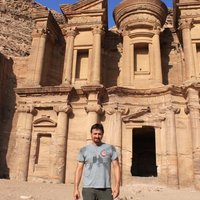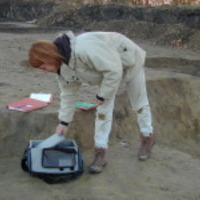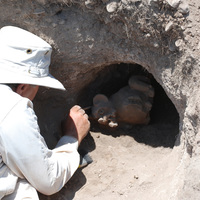
Janet davidson
Related Authors
Nerissa Russell
Cornell University
Philipp Wolfgang Stockhammer
Ludwig-Maximilians-Universität München
Enrico Cirelli
Università di Bologna
Marie Louise Stig Sørensen
University of Cambridge
Yannis Hamilakis
Brown University
Michael Dietler
University of Chicago
Viktória Kiss
Hungarian Academy of Sciences
Gary Feinman
Field Museum
Alfredo González-Ruibal
Independent Researcher
Veena Das
Johns Hopkins University










Uploads
Papers by Janet davidson
individuals excavated from two burial mounds located at the `Atele burial site on Tongatapu, the main island of the Kingdom of Tonga (c. 500 - 150 BP). The first burial mound (To-At-1)
was classified by some archaeologists as a commoner’s mound while the second burial mound (To-At-2) was possibly used for interment of the chiefly class. In this study, stable isotope analyses of diet (δ13C, δ15N, and δ34S; n = 41) are used to asses paleodiet and 87Sr/86Sr ratios (n = 30) are analyzed to investigate individual mobility to test whether sex and social status affected these aspects of life. Our results show significant differences in diet between burial mounds and sexes. Those interred in To-At-2 displayed lower δ13C values, indicating they ate relatively more terrestrial plants (likely starchy vegetable staples) compared with To-At-1 individuals. Females displayed significantly lower δ15N values compared with males within the entire assemblage. No differences in δ34S values were observed between sexes or burial mound but it is possible that sea spray or volcanism may have affected these values. One individual displayed the strontium isotopic composition
representative of a nonlocal immigrant (outside 2SD of the mean). This suggests the hegemonic control over interisland travel, may have prevented long-term access to the island by
non-Tongans exemplifying the political and spiritual importance of the island of Tongatapu in the maritime chiefdom.
individuals excavated from two burial mounds located at the `Atele burial site on Tongatapu, the main island of the Kingdom of Tonga (c. 500 - 150 BP). The first burial mound (To-At-1)
was classified by some archaeologists as a commoner’s mound while the second burial mound (To-At-2) was possibly used for interment of the chiefly class. In this study, stable isotope analyses of diet (δ13C, δ15N, and δ34S; n = 41) are used to asses paleodiet and 87Sr/86Sr ratios (n = 30) are analyzed to investigate individual mobility to test whether sex and social status affected these aspects of life. Our results show significant differences in diet between burial mounds and sexes. Those interred in To-At-2 displayed lower δ13C values, indicating they ate relatively more terrestrial plants (likely starchy vegetable staples) compared with To-At-1 individuals. Females displayed significantly lower δ15N values compared with males within the entire assemblage. No differences in δ34S values were observed between sexes or burial mound but it is possible that sea spray or volcanism may have affected these values. One individual displayed the strontium isotopic composition
representative of a nonlocal immigrant (outside 2SD of the mean). This suggests the hegemonic control over interisland travel, may have prevented long-term access to the island by
non-Tongans exemplifying the political and spiritual importance of the island of Tongatapu in the maritime chiefdom.